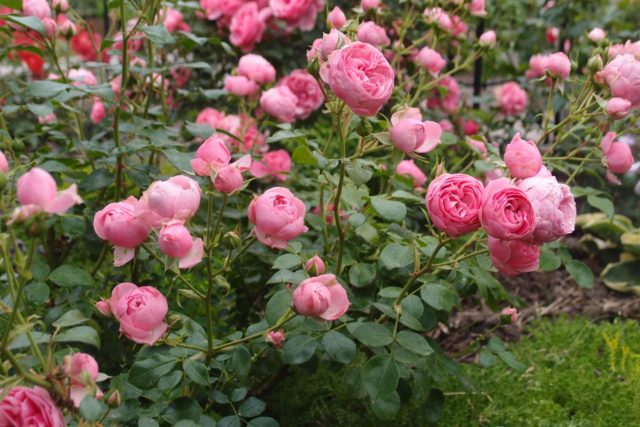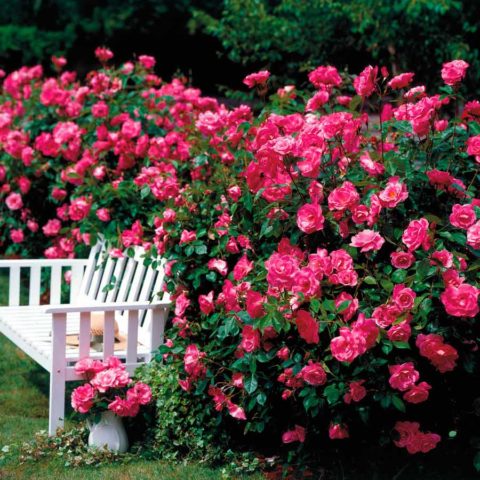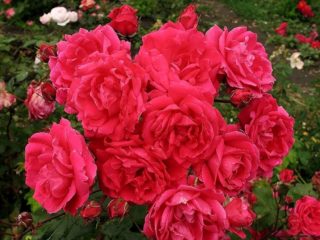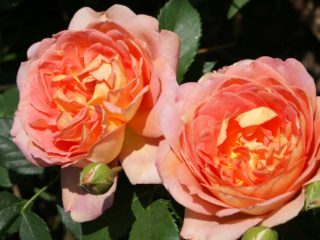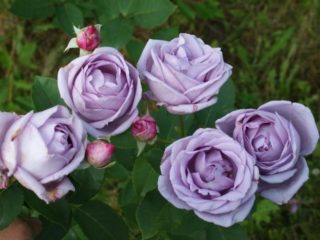Content
- 1 Breeding history
- 2 Description of the variety of roses floribunda Pomponella and characteristics
- 3 Advantages and disadvantages of the variety
- 4 Reproduction methods
- 5 Growing and care
- 6 Pests and diseases
- 7 Application in landscape design
- 8 Conclusion
- 9 Reviews with photos about rose floribunda Pomponella
Rosa Pomponella is a medium-sized, beautifully flowering variety of decorative culture widely used in landscape design. Not picky about growing, but needs some attention. In the first year of life, "Pomponella" blooms poorly, mainly spends energy on adapting to a new place. The appearance of a large number of buds is observed only in the second year, subject to proper care.
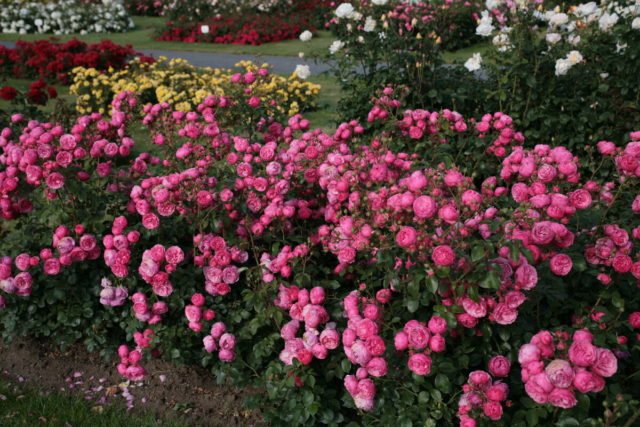
Polyantova "Pomponella" is an unpretentious variety, but requires due attention
Breeding history
Rose Pomponella (Pomponella) belongs to the class Floribunda, series "Fairy Rose" (rootstock - rose hips). It was opened to the world in 2005 by German breeders of W. Kordes Sons corporation. Thanks to the work of specialists, the new crop variety has turned out to be unpretentious in cultivation, resistant to frost and diseases, and has an exquisite appearance. Due to its active growth, the rose is more related to scrubs.
The following year after its discovery, this floribunda variety received the ADR quality seal, which is awarded only to resistant varieties with abundant flowering. Since then, she has regularly participated in various international competitions and exhibitions.
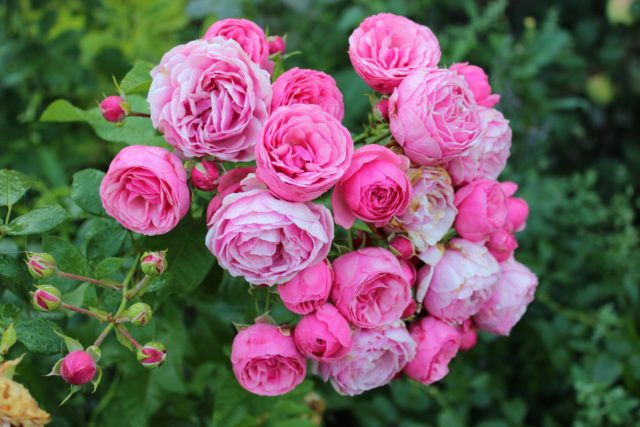
Rose has received many awards and certificates
Description of the variety of roses floribunda Pomponella and characteristics
The pompom pink floribunda rose is considered an unpretentious and undemanding crop to care for and soil, with a high resistance to diseases. It is a lush, erect, branched bush with strong shoots. The rose grows in height up to 190 cm, in width up to 160 cm.When grown in comfortable conditions, it often exceeds the declared size. Flowers of the "Pomponella" variety are densely double, have a bright pink color and a delicate pleasant aroma. The buds are 4-5 cm in diameter, each containing 80 to 85 petals. Outwardly, they resemble pompons, collected in large inflorescences, of which there can be up to 15 pieces on the stem. In the process of flowering, they are able to change their shape from conical to spherical. The foliage of the rose is dense, dense, dark green in color, slightly shiny.
The floribunda "Pomponella" is characterized by abundant formation of shoots, therefore, the variety needs mandatory pruning. Flowers keep their shape perfectly in any weather, are not afraid of heavy rain or wind, but due to the severity of the buds, experienced gardeners advise tying whips to supports.
The rose is characterized by a long flowering period. With quality care, it begins to bloom in the second half of May and continues to delight summer residents with its beauty until mid-September, in warm climatic conditions - until winter.
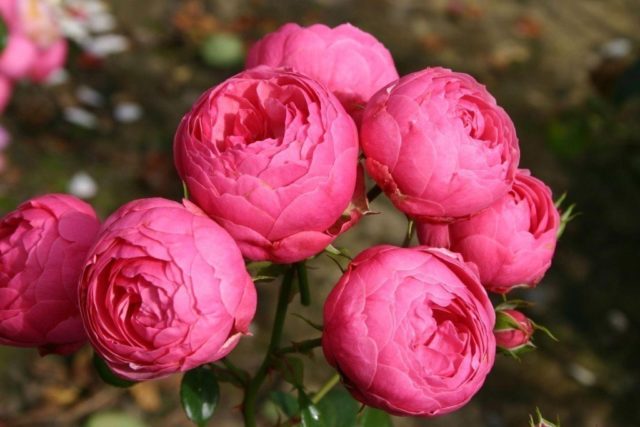
Abundant flowering "Pomponella" can be interrupted for a short time
Advantages and disadvantages of the variety
Polyanthus rose "Pomponella", like any plant, has its pros and cons. The main positive characteristics of the variety include:
- Endurance... The dense foliage of the floribunda is well resistant to diseases and attacks of harmful insects. After transplantation, the culture quickly takes root, it tolerates winter well. The buds are not damaged by wind and rain.
- Decorativeness... "Pomponella" has an interesting flower shape, retains an attractive appearance even after cutting.
- Duration of floweringI.Floribunda bushes are covered with numerous flowers throughout the summer.
If we talk about the disadvantages of the variety, then it should be mentioned that it does not tolerate hot weather and areas in the open sun. Under the scorching rays of "Pomponella" petals begin to fade and burn out. In addition, towards the end of the season, the crop throws out long shoots and begins to look untidy. Some say that the rose has a simple and uninteresting monochromatic color.
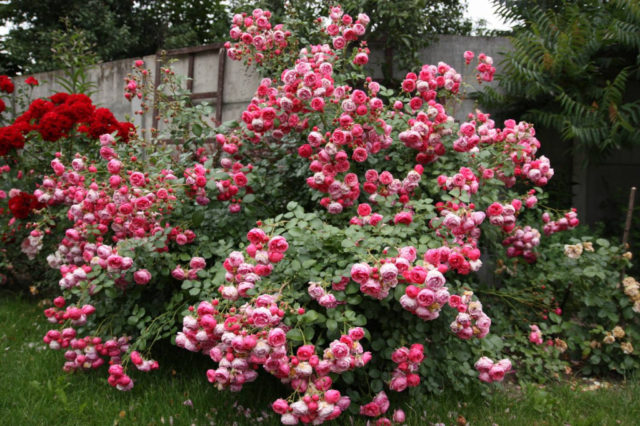
A floribunda rose is considered a plant for an amateur, not all growers like it
Reproduction methods
The most common breeding option for the Pomponella rose at home is cuttings. The method is simple, it perfectly preserves the varietal characteristics of the crop. Perform as follows:
- A cutting about 8 cm long is cut from a healthy floribunda shoot 5 mm above the bud at an angle of 450.
- Remove all thorns and leaves from it.
- They are treated with a growth stimulant.
- They are planted in fertile soil.
Instead of soil, the stalk can be stuck into the potato tuber, and after a while, when it takes root, plant it in a pot or soil.
Growing and care
Rose "Pomponella" corporation "Cordes" does not require much effort to grow. Even a novice gardener can cope with planting a culture and subsequent care.
It is customary to plant seedlings of this type of floribunda in open ground in mid-spring or early autumn. It is better to choose a place for planting in the shade, near buildings, with a low occurrence of groundwater, good air and moisture permeability. It is best if the soil is slightly acidic, rich in humus, loamy.
Rose care includes standard procedures:
- Watering... It is enough to moisturize the plant once a week. One bush requires 1-1.5 buckets of water.
- Loosening... It is advisable to carry out after each watering.
- Mulching... Wood shavings are best suited for this.
- Top dressing... Floribunda Pomponella responds well to compound fertilizers. Compost and manure will help to saturate the soil with organic matter, peat will increase fertility, minerals will improve flowering. Fertilization of "Pomponella" with bone meal, wood ash and iron vitriol will be no less useful.
- Pruning... To rejuvenate the floribunda rose bush throughout the season, thin, inward-growing and lateral shoots should be cut from it. It is also recommended to remove all old and dried branches, wilted flowers.
- Shelter for the winter... Despite the high frost resistance of "Pomponella" (up to -20 degrees), its bushes for the winter should be spud and covered. Before this, the shoots must be cut off, and the top layer of the earth must be loosened.
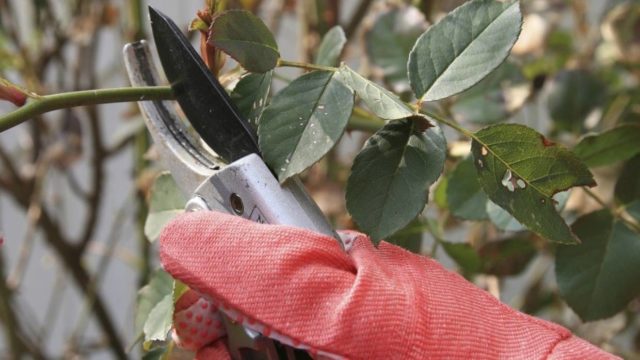
Floribunda Pomponella tolerates both planting and replanting well
Pests and diseases
The pompom rose variety has excellent resistance to various diseases, especially to such a common disease as black spot. Of the ailments that can affect "Pomponella", it is worth noting such as powdery mildew and bacterial cancer.
As for pests, more often than others, the Cordes rose is attacked:
- spider mite;
- aphids;
- rose leaf roll.
Application in landscape design
Pomponella floribunda, which has a very effective appearance, is often used to create original garden landscapes. Mostly the rose is grown in mixborders and border plantings. The culture is great for decorating fences, hedges and gazebos. Looks beautiful with pompom roses of other varieties: Misty Bubbles or Ascot. Interesting in composition with such neighbors as Leonardo de Vinci, Peter Paul Rubens, Golden Border.The variety of pink shades is demonstrated with the varieties Hans Gonewein Rose and Geoff Hamilton. Due to the high reparability of flowering and the peony-shaped shape of the buds, the pomponella rose is placed on the trunk, where it looks very advantageous. The plant looks no less impressive in single plantings.
This floribunda variety can be used in any style of flower bed, from country country to pompous French garden.
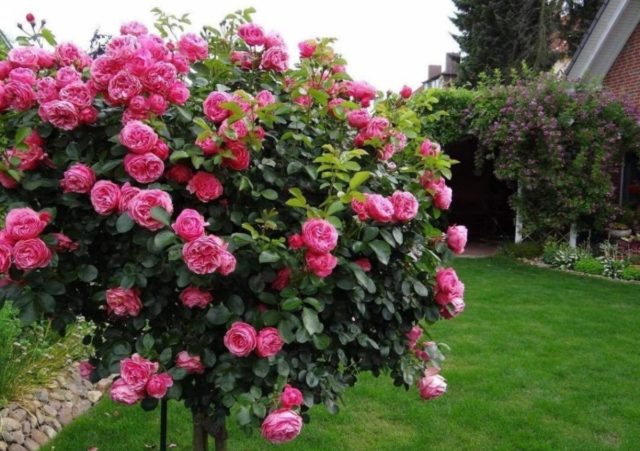
The stem is grown in a special way, the rose looks like a small brightly blooming tree
Conclusion
Rosa Pomponella is a hardy and reliable variety in the Floribunda class. Its main features are considered to be generous long-term flowering with original dense double flowers and good resistance to environmental factors. The culture has received several gold and silver awards, received a large number of certificates and has earned many positive reviews. Often "Pomponella" becomes a decoration of gardens and household plots of different countries of the world, it is successfully grown in Russian regions.
